Learning usually requires repetition while forgetting occurs when
I infrequently use information. Many young learners do not understand
the importance of repetition. Weekly visits to the bridge provided
the repetition necessary to detect changes in the bridge and
consequently generated
many questions and opportunities for learning. Over the course of the
bridge project, I had access to few experts for answering questions.
Rather than a liability, this became an asset and pushed me to improve
my search skills with Google. Soon, I found that answers
to questions encountered during my weekly photo shoots were often
only a Google-search away -
(see
Restoring the Joy in Learning). Consequently Google + Internet became
dependable extensions of my memory.
The bridge story is a work in progress and is evolving from a simple
collections of photographs to an experiment with Internet-centric
just-in-time learning.
Insights I gain from you
will find their way into the learning centers of MUSC.
Palmetto Bridge Constructors, a joint venture between
Tidewater
Skanska and
Flatiron Constructors, as well as
High Steel Structures,
Freyssinet, the
SCDOT and the
Federal Highway Commission Office
of Bridge Technology guided much of my learning.
I also learn from many of you and from Google-linked resources. More
important is the e-mail encouragement I receive from many of you.
With the demolition of the Pearman and Grace moving ahead (briskly), I
understand that this platform will be removed when the vertical supports
are removed. Then the bicycle lane paving will be completed.
But what a perfect spot to place a few park benches
so that walkers can stop, rest and contemplate not only our wonderful
bridge, but life, the universe and everything. So what about this option,
is it possible to modify the contract with Cashman-Testa to not remove
the wooden platform and for the City to populate it with a few park
benches - particularly useful to maturing adults (age > 60)?
Vince Streano convinced me that I should take my serious photos using
RAW image formats instead of jpg - due to small artifacts introduced
by the data compression process. For most of my academic work, open source
tools meet 80 - 90% of my needs. This morning I took a photo of the
Ravenel Bridge just to test the idea - in both RAW and high resolution
JPEG format.
Here is an early morning photo of the Ravenel Bridge with the Pearman
and Grace Bridges in the background
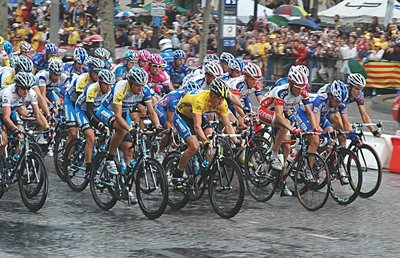
It was July 21, 2004 when David Wertz from SCDOT provided me with my first
inside look at the bridge construction processes. The motivation came
from Bill Mankin at High Steel Structures in Lancaster Pa - who had been
exchanging email with me about which steel came from them and which steel
came from other vendors. About a week before I noted that some edge
girders were being lifted using cranes anchored in the river and wondered
about how the stability of the crane barge was adequate for the precision
placement of the edge girders.
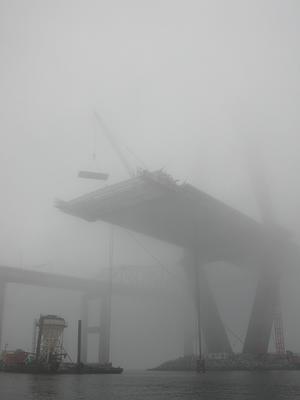 The fog that day was thicker than pea soup and it was impossible to see
the erection process from the water. So we visited the deck of the
left main span. While waiting for the fog to clear we were invited to
look at the cable installation process inside the west pylon. This was
my first exposure to the French group of Freyssinet. Later, we visited
the top of the west tower and looking down I watched the Freyssinet
guy direct the strands of cables as they were fed from the anchorage
area see ( for the details).
He was wearing a Freyssinet t-shirt and with Google I found that Freyssinet
was a French company. I thought to myself, wow, what a great vantage
point to watch the final stages of le Tour de France - even if it is
3000 miles away.
The fog that day was thicker than pea soup and it was impossible to see
the erection process from the water. So we visited the deck of the
left main span. While waiting for the fog to clear we were invited to
look at the cable installation process inside the west pylon. This was
my first exposure to the French group of Freyssinet. Later, we visited
the top of the west tower and looking down I watched the Freyssinet
guy direct the strands of cables as they were fed from the anchorage
area see ( for the details).
He was wearing a Freyssinet t-shirt and with Google I found that Freyssinet
was a French company. I thought to myself, wow, what a great vantage
point to watch the final stages of le Tour de France - even if it is
3000 miles away.
Each year, my son-in-law, and economist that studies French and California
agriculture policies related to wine production, rents a flat in France and
Ellen and I provide babysitting duty. This year Trevor rented a flat about
6 - 8 blocks from the Arc de Triomphe, where the race would end with several
loops up the Champs Elysees. What an opportunity to close the loop
with Freyssinet that started the year before. We arrived in Paris on the
23rd and Sunday about 1pm we made our way to the Champs Elysees to watch
and maybe photograph the finish.
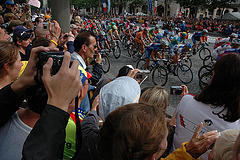 The crowd was wall to wall people - even 4 hours before the peloton arrived -
and I am impatient and what to do standing in place for 4 hours? I decided
that the crowd and the competition for photos was really worth documenting and
took this photo - just to show all the cameras (count them if you can). I
was about 3 rows back - and the only way I could take an unobstructed photo
was to hold the camera high above my head, aim and click - blindly taking
photos of whatever my camera was pointed toward.
The crowd was wall to wall people - even 4 hours before the peloton arrived -
and I am impatient and what to do standing in place for 4 hours? I decided
that the crowd and the competition for photos was really worth documenting and
took this photo - just to show all the cameras (count them if you can). I
was about 3 rows back - and the only way I could take an unobstructed photo
was to hold the camera high above my head, aim and click - blindly taking
photos of whatever my camera was pointed toward.
After the finish, Trevor and I returned home downloaded our photos and
discovered we caught Lance Armstrong and his Discovery team on their first
pass up
the Champs Elysees. For the story of our Paris holiday and photos
of the Tour de France
visit
our Paris flat, dinners on our terrace and views of many
interesting things.
The adventure from July 21 2004 and my introduction to Freyssinet to July 24,
2005 and the finish of le Tour de France cannot be described.
For this adventure, I thank Trevor, of
course, Marvin Tallent, an avid cyclist who works for Flatiron and
was in charge of QA and QC for the bridge and was my guide for many
constructions issues, and finally
Oliver Forget and his colleagues at Freyssinet who shared with me an inside
look at stay cable installation and testing.
posted at: 07:24 | path: | permanent link to this entry
Thu, 21 Jul 2005
July 21, 2005: Transition from building to unbuilding

The construction of the new Cooper River Bridge is complete. The
fireworks and opening ceremony, from my perspective, breathed new
life into our community. Certainly use of the bicycle
and pedestrian walkway during the first days demonstrated both their
utility and the vision of the bridge sponsors.
There is a first chapter and a last chapter with every story and
our bridges are no different. I have started preparations for
keeping our stories alive, now as historical documents. As a
first step, I am moving the Internet address of the Ravenel Bridge story to
http://ravenelbridge.net. This
will provide a stable location and facilitate transition of the site
to a future home, perhaps the Charleston Public Library or the
Historical Society. I have not explored this with any agency, but it
seems to me that our web site (yes, not mine) would be better preserved
under the leadership of a public agency.
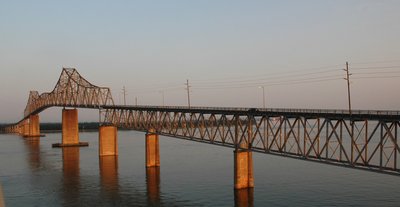
Yesterday I started the first chapter of the unbuilding of the
Grace and Pearman bridges. I have moved the Internet address for
our new story to
http://oldcooperriverbridge.org. I shall continue to take
weekly, and in some cases, daily (early morning and late afternoon)
photos of the Charleston approaches, Mt. Pleasant approaches and
the main bridge spans. In addition, I will build a new section
addressing engineering issues and insights, similar to the
Engineering and
Close-ups section I developed around the construction of the
Ravenel bridge.
Many of you have fed me ideas and questions. As we start our new
story, please continue to write me. Let our learning continue!.
posted at: 03:45 | path: | permanent link to this entry
Sun, 17 Jul 2005
July 16, 2005: The meaning of a signature bridge
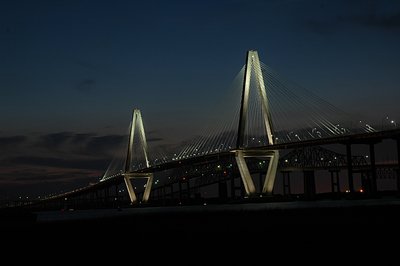 From Walter Baker in California:
From Walter Baker in California:
I saw a news article on
the opening of the Arthur Ravenel Bridge. I put its name in a search engine
and fortunately found my way to your website. I became wonderfully
distracted by your photographic documentation of the bridge construction. I
want to thank you so much for the time and effort you put into this project.
You live in a beautiful area of our great country and now it has been
crowned by a wonderful work of art. I offer you the following.
Easy it is to be cynical,
In the days in which we live,
But every now and then,
A ray illuminates the darkness
And spans the gap to heal.
A sense of unity once thought lost
Found on the other shore,
And brought home to rest
In the warmest place once more.
There will be times when this is forgotten
And all the worlds in a rage,
But from a distance its image shines,
The crossing place forever in the mind.
W Baker
posted at: 05:31 | path:
|
permanent link to this entry
Sat, 16 Jul 2005
July 16, 2005: The meaning of a signature bridge
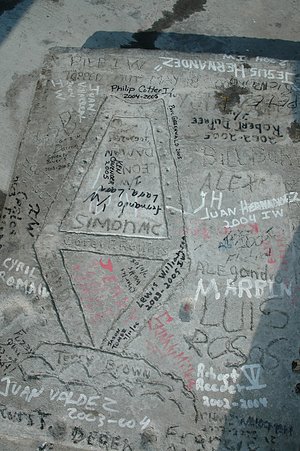 Yesterday, Vince Streano, David Wertz and I revisited the top of the
west tower. It was almost 1 year ago (July 21, 2004) that David and
I visited the top of the west tower - at that time looking at a number of
bridge engineering issues. Among them was the cabling process managed
by Olivier Forget from Freyssinet
- and the time was near the end of "le Tour de France". During an
earlier visit to the top of the west tower, I noticed a concrete tablet
on the floor (upper left) with the names of many of the construction
workers. Dumb Frank did not record this photographically at the time. This
time I was not going to repeat the same mistake twice. Not only did I take
several photos of the tablet, but I found Philip Cotter's and Lewis
Williamson's names on the tablet. Philip and Lewis are iron workers, a
very special breed of man that suspended themselves while erecting
edge and floor girders and placing the concrete floor panels. Philip's wife,
Tina, exchanged a number of emails with me about Philip and his
artistic and literary skill - naming the last main-span crane (east side)
the "Last Dinosaur Standing" (see
for the dinosaur story).
Yesterday, Vince Streano, David Wertz and I revisited the top of the
west tower. It was almost 1 year ago (July 21, 2004) that David and
I visited the top of the west tower - at that time looking at a number of
bridge engineering issues. Among them was the cabling process managed
by Olivier Forget from Freyssinet
- and the time was near the end of "le Tour de France". During an
earlier visit to the top of the west tower, I noticed a concrete tablet
on the floor (upper left) with the names of many of the construction
workers. Dumb Frank did not record this photographically at the time. This
time I was not going to repeat the same mistake twice. Not only did I take
several photos of the tablet, but I found Philip Cotter's and Lewis
Williamson's names on the tablet. Philip and Lewis are iron workers, a
very special breed of man that suspended themselves while erecting
edge and floor girders and placing the concrete floor panels. Philip's wife,
Tina, exchanged a number of emails with me about Philip and his
artistic and literary skill - naming the last main-span crane (east side)
the "Last Dinosaur Standing" (see
for the dinosaur story).
Here, permanently placed on the top of the west tower is a symbol of the
worker's bride. Many signatures are absent - but the pride runs all the
way from Bobby Clair through Wade, Peo, Marvin, David and Olivier all the
way to me - as these folks opened doors that enabled me to bring to you
much of the untold stories behind building our Arthur Ravenel Jr. Bridge.
And a final note about the Internet and learning. The Internet provided
me a medium that enabled me to share with you what the bridge folks shared
with me. Not only that, the Internet provided a communication medium that
linked me with Bill Mankin at High Steel, with engineers at the Federal
Highway Administration, Bridge Division, with Buckland and Taylor,
T. Y. Lin, HDR, Freyssinet and Tidewater Skanska. Governor Sanford
and Bob O'Brien even provided input. In the end, Bob has suggested
that I explore transfering
this web site to the Historical Society or the Library -
a wonderful strategy for breathing new life into these pages.
So from me - smiles and a big thank you to all of you!
Frank Starmer, Medical University of South Carolina.
posted at: 12:02 | path: | permanent link to this entry
Mon, 04 Jul 2005
July 4, 2005:
Le Tour de France and our International Family
The 2005 Map of Le Tour de France: A one year anniversary of close encounters with bridge builders:
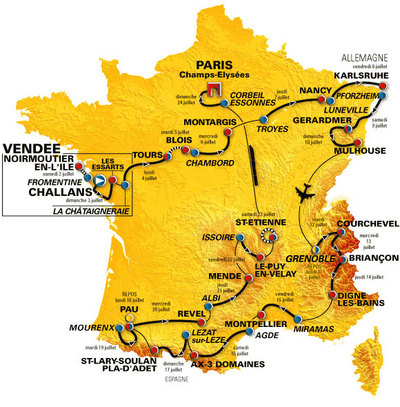
Almost a year ago (July 21, 2004),
David Wurtz gave me my first bridge building seminar on the
platform of the
west span. As part of our seminar we made a visit to one of
the cable construction stations in
the interior of the west pylon which is how I discovered Freyssinet.
Later Olivier Forget, the leader of the international
Freyssinet team, as well as
Eduardo, Cyril, Jose, Pavil, Bruno, Philiu and Niko joined our seminar and helped me
to understand the design, construction and testing of stay cables.
Now, a year later, the Tour de France has just started and I am
remembering the excitement of my first visit to the main span. Wade,
Peo, Marvin, Brian, Lori, Wilbur, Derik and many many others gave
these pages a bit of life. Thanks to all of them!
posted at: 10:00 | path:
|
permanent link to this entry
Wed, 22 Jun 2005
June 22, 2005: About these web pages
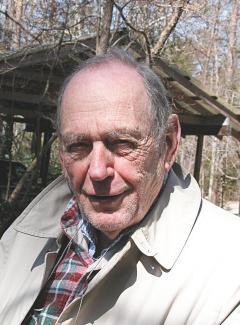
On June 12, 2005,
Gene
Stead, 97 years of age, quietly died. Gene was Chairman
of Medicine at Duke from 1947 - 1967 and was my first boss. But he was more
than a chairman. He paid great attention to individuals, whether
faculty, students or patients, and worked at
enabling them to reach beyond their grasp. He understood that problems
could rarely be solved by technology alone and demonstrated over and over
again that success often rides on resolving personal and cultural issues.
Several years ago, my son, Josh, and I visited Gene for the weekend. Gene
was frustrated by the difficulties in maintaining communication with younger
people. We talked about the Internet, about Google, about what to learn
and how to avoid the
forgetting curve.
We shared our frustration that
many younger people have lost their curiosity and wrote a short paper about
restoring the joy in learning and about
learning and forgetting. I built his
web site as a tool for exploring
Internet-centric learning and addressing issues of curiosity and
forgetting. These pages about the building of
the new Cooper River Bridge (Ravenel bridge) reflect a continuation of
our explorations in learning, sharing and igniting curiosity among young
learners.
posted at: 08:25 | path:
|
permanent link to this entry
Fri, 17 Jun 2005
June 17, 2005: Exploring Graphical Navigation
I am often frustrated with the difficulty of finding stuff on
these web pages. I think there must be a better way. Jack, my son,
suggested some sort of graphical navigation. The idea is that you
can click on a region of an image and bring up more detailed photos.
I have built a rough draft
test page to develop this idea. There are about 2500 images
and finding what even I want, well, its simply out of control.
Perhaps a graphical interface with the photos is the way to do. Google
does this with Google Maps using
Ajax (asynchronous javascript and xml), a new web technology. This is
not
Ajax - just plain ordinary javascript - but a start.
I need your input, your ideas, your code, your whatever.
posted at: 13:21 | path: | permanent link to this entry
Mon, 13 Jun 2005
June 13, 2005 Humorous stories
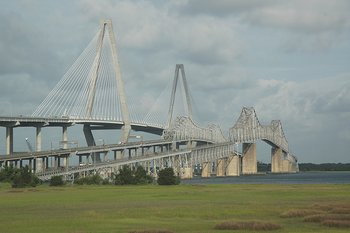
From time to time, I receive some humorous stories of past experiences with
the Grace bridge. This seems like the best place to share them. To the right
you see (right to left) the Grace, Pearman and Ravenel bridges. Note the
steep incline associated with the older bridges. (Click the image for a larger
format.)
J. LaVerne Ard, former mayor of Pamplico, SC and VP of Marsh Lumber Company - circa 1950 story (as told by Bette Cox, Florence, SC):
"As a high school teenager, he drove a flatbed truck during the summer.
One trip to Charleston was for a load of fertilizer. Trying to come back
across the bridge with the flatbed fully loaded, a traffic light caught him,
and when it turned green, the truck simply wouldn't climb the grade.
He sent his little brother to the back of the truck to lay sacks of
fertilizer against the back wheels to keep from rolling back into the traffic
behind him. Then, along came a policeman.
The helpful policeman stopped all traffic, had him back up about two blocks
and rev the motor to get a running start, and cheered him on as the truck
chugged up the hill and on across the bridge."
Terry Edmonds, Apex NC
"When I was 15, in 1963, and had just gotten my learners permit to drive,
my father, sister and I drove from Wilmington, NC to Tampa, FL for Christmas.
I was driving on Hwy. 17 when we got to Mt. Pleasant. The old 2 lane bridge
into Charleston came as a very un"Pleasant" surprise. Dad just looked at me
and said that I was driving. Two way traffic on that old bridge was terrifying.
I must have left clear indentations on the steering wheel with both hands.
Never will forget it. And, I have told my kids the story so often that all of
them have reported back to me when they made their first trip across
'the bridge'. "
posted at: 10:00 | path:
|
permanent link to this entry
Thu, 09 Jun 2005
June 9 2005: Opening Dates Announced
|
Patiently waiting is not one of my virtues but I have learned that waiting
impatiently takes just as long. Here is the best information I have,
following an announcement from SCDOT today (June 9, 2005):
|
| July 9 Saturday afternoon |
Bridge Open for pedestrian strolling |
| July 10 Sunday afternoon |
Bridge Open for pedestrian strolling |
| July 11 Monday evening |
Fundraising event |
| July 14 Thursday evening |
Fireworks then stay-cable lighting |
| July 16 Saturday 9am |
Bridge Dedication and formal opening |
|
Other event times are a bit uncertain, but I shall post them as soon
as I find out
|
posted at: 10:00 | path:
|
permanent link to this entry
Wed, 08 Jun 2005
June 8 2005: A short web lesson:
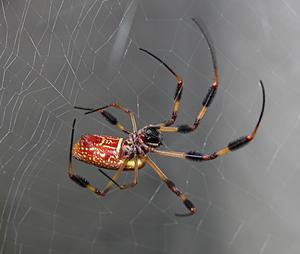 Managing a small web site is a challenge, a learning opportunity and
an opportunity to explore my Google-Internet memory amplifier.
In addition to the bridge web pages, I follow the lives of a few
spiders in our garden and built web pages which reveal a bit of their lives
(see Natasha or
mating banana spiders). Every morning I review the web access logs to
see what is happening.
Managing a small web site is a challenge, a learning opportunity and
an opportunity to explore my Google-Internet memory amplifier.
In addition to the bridge web pages, I follow the lives of a few
spiders in our garden and built web pages which reveal a bit of their lives
(see Natasha or
mating banana spiders). Every morning I review the web access logs to
see what is happening.
This morning I saw that Google-directed hits to our banana spider pages
are increasing and almost equal to the Google-directed hits to
our new Cooper River Bridge web pages.
What is the software base that enables me to manage these web pages?
I use the open source distribution of GNU-Linux
from RedHat
for my web server environment which includes
Apache as the web serving software.
For development, I use the GNU-Linux distribution from
the RedHat
sponsored Fedora project which also includes Apache. Finally, I use
Google to answer technical questions that
arise when I am building these web pages.
Apache writes an entry into either an access log or an error log each
time a web page is accessed. Monitoring the logs helps track web site
access patterns and identify errors that creep
into these web pages. To analyze the logs, I use
AWstats. This tracks
where web page requests originate and more important, summarizes the
search expressions
used to access web pages. From these data, I can directly see what is
interesting and what is never touched. This provides guidance for
experimenting with different ideas and determining how to better meet the
needs of readers.
Here is the table from the
summary of web activity since Sunday June 5.
| key phrases | Frequency | Percent |
| banana spider | 160 | 4.5 % |
| cooper river bridge | 128 | 3.6 % |
| new cooper river bridge | 52 | 1.4 % |
| ravenel bridge | 51 | 1.4 % |
| butterflys | 47 | 1.3 % |
| banana spiders | 41 | 1.1 % |
| forgetting | 31 | 0.8 % |
| french wildlife | 24 | 0.6 % |
| matrix calculus | 22 | 0.6 % |
| charleston bridge | 18 | 0.5 % |
| arthur ravenel bridge | 15 | 0.4 % |
| nernst-planck equation | 13 | 0.3 % |
| nephila clavipes | 13 | 0.3 % |
Note: I never know when I'll learn something new - and making this
blog entry provided
an unexpected surprise. When I first wrote the above, I had forgotten the
HTML tags for a table header - so I used
Google and the search words: how to make html table . The first
entry:
sorttable: Make all your tables sortable did not answer my question but
revealed a way to enable browser-based sorting of columns within a table.
Since this looked like a fun idea, I followed their recipe and suddenly
the colums in the above table became sortable.
The total time required for this experiment - 10 minutes.
Curious about other tricks available from this site, I
backed up a level
and found a collection of interesting
scripts for enabling other browser-based presentation features.
This is a typical example of the positive impact associated with
chasing curiosity within our Internet connected world.
posted at: 10:00 | path: | permanent link to this entry
Thu, 02 Jun 2005
June 2, 2005: The simple elegance of symmetry - without words
The real thing
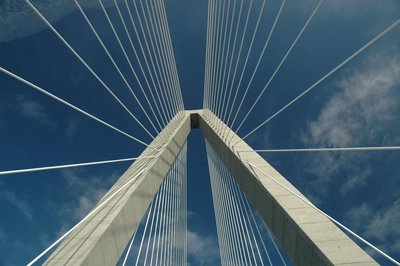
A digital sketch

posted at: 10:00 | path:
|
permanent link to this entry
Sun, 29 May 2005
May 29, 2005: Learning from the bridge and the Internet

Our new Cooper River Bridge is a great motivator for learning.
That said, Google + the Internet are
great resources for both learning and for remembering.
(If you see a disconnect, visit the
forgetting curve.)
Earlier this week I faced the challenge of learning how to stitch photos
together in order to make a panoramic presentation. The results (see below)
were ok, but the junction of the images was apparent, particularly the
junction of the left image and its neighbor. Since this is Charleston,
2nd class results are simply not acceptable, so I faced another challenge -
how to improve the blend between the images.
Last week, I found an open source program
hugin - a Panorama Tools GUI
available from Sourceforge.
Last night, I started my search with Google and
found a link to another Sourceforge offering,
Enblend, as well as a tutorial
about
blending exposures using Gimp. I visited the enblend web site and
sure enough, there was both an example, based on Hugin, which I used last
week to build the panoramic image as well as the code for computing
the blended image. So I downloaded the code, and another surprise, it
compiled without an error. I then followed the instructions and created
the above result. Needless to say, I was grinning from ear to ear.
A word about open source software. I have been associated with open source
resources since I obtained our
Unix license
at Duke in 1974. Although open
source software is often called free software,
it requires some effort to build, integrate and use.
Richard Stallman, a champion of
the open source movement,
prefers that the term, free, refer to the personal liberty that
is associated with the use of open source software and not its cost.
These bridge web pages reflect the freedom and liberty associated with
being able to access and integrate open source software in producing
a result. For example, my web server software is
Apache and my
desktop system runs
Fedora Linux.
At the application level,
Gimp is my image processing tool, now joined
by ImageMagick,
Enblend
and
Hugin.
posted at: 16:12 | path: | permanent link to this entry
Wed, 25 May 2005
May 25, 2005: A view from the top - Exploring photo stitching

Sunday found me on the bridge again to check out what had happened the night
before. What had happened was a lot of paving on the outside south lane.
Also Murray and Wade were deep in discussion and suddenly there was an
opportunity to visit the top of the west pylon. This time, I was
determined to take a series of photos of the horizon and later to
try to piece them together to make a panorama.
I was in luck - the temperature was cool, the humidity was low and the
view was perfectly clear. At home, I found an open source program
hugin - a Panorama Tools GUI
available on
sourceforge,
a really great resource where many many people
manage open source development projects (including my
IT Lab at MUSC). So I downloaded
the software, installed it, followed their how to tutorial
and tried to piece two images together. It worked
the first time - so I tried 4 photos stiched together. It worked as you can
see above.
Whether it is the bridge project or open source software or research, Google,
as the card catalog and the Internet, as our library, level the playing field
such that everyone has access to the same resources. Only our energy
level and curiosity make a difference.
posted at: 10:00 | path: | permanent link to this entry
Mon, 16 May 2005
May 16, 2005: Pylon airflow
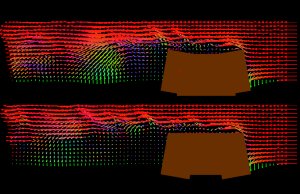 Sometimes you never know when your past will catch up with you. When I first
came to MUSC, our outsourced IT support folks could not execute within my
frame of reference - Internet-centric learning. So I formed the Information
Technology Laboratory, aptly named the IT Lab by Nafees BinZafar, one of my
first. The IT Lab was set up to give me the freedom to execute within the
web world and I can honestly say that I have learned more from them than they
from me. I simply ignited their curiosity fuse and then got out of their
way. One of the few rules in the
IT Lab
was that you cannot resign - only graduate.
Sometimes you never know when your past will catch up with you. When I first
came to MUSC, our outsourced IT support folks could not execute within my
frame of reference - Internet-centric learning. So I formed the Information
Technology Laboratory, aptly named the IT Lab by Nafees BinZafar, one of my
first. The IT Lab was set up to give me the freedom to execute within the
web world and I can honestly say that I have learned more from them than they
from me. I simply ignited their curiosity fuse and then got out of their
way. One of the few rules in the
IT Lab
was that you cannot resign - only graduate.
Nafees and Nathan are two of my graduates that now work for Digital Domain -
doing systems and animation infrastructure - and they continue to contribute
back to our IT Lab. Today Nafees wrote and confessed of being confused by
the design of the tops of the east and west pylons. Being a well trained
graduate of my IT Lab, he did a simulation to explore two different
alternatives.
In his words
Hi Frank. I've been looking at your cooper river bridge pictures.
And I wondered why the tops of the towers were indented, and not flat.
I guessed it had to be for aerodynamic reasons, but I couldn't find anything
on the web about the exact reasons. So I ran a simulation. I couldn't
find the exact dimensions for the tops, so I eyeballed it from your
pictures. For comparison I modelled a tower with a flat top.
I suppose I should have done one with a pointed top also.
I'm attaching movies of the top view and the side view of the simulations.
The wind is blowing in at about 22 mph. The massless tracer smoke is
generated by 2 sources; 1 on top, and 1 on the leeward side. The sims
didn't really show anything numerically conclusive. My simulation
resolution is much too low for that. The vortex shedding frequency seems
a little bit higher in the "flat-top" configuration, and downstream
the flow is more turbulent. Also, there is a very substantial pressure
drop in the indented region. So I suspect that you will have some
really good photo-ops of condensation trails on a cold and windy day.
Here are the two videos (avi and mpg format). As with any collaborative
effort, there are issues. In this case, the avi or mpg files may require
some care when displaying. We are exploring alternative formats.
posted at: 14:23 | path:
|
permanent link to this entry
Sun, 08 May 2005
May 8, 2005: Our extended bridge family
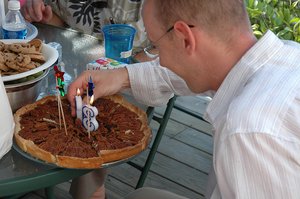 It is all about people chemistry. New chemical compounds are impossible
as long as the reagents live in their individual bottles. Mix them together,
add a bit of heat (sometimes) and something interesting might happen. The
same with people. When I sit in my office or home, bottled as a chemical
reagent in the supply room, nothing interesting happens. When I get up and
poke around, I collide with others, and the possibility of something
interesting is amplified. So it is with our bridge project.
It is all about people chemistry. New chemical compounds are impossible
as long as the reagents live in their individual bottles. Mix them together,
add a bit of heat (sometimes) and something interesting might happen. The
same with people. When I sit in my office or home, bottled as a chemical
reagent in the supply room, nothing interesting happens. When I get up and
poke around, I collide with others, and the possibility of something
interesting is amplified. So it is with our bridge project.
Earlier this week, Sandrine phoned me about a surprise birthday party for
her husband, Oliver (who directs the local Freyssinet work). This was
a complete surprise for me because Sandrine did not have my phone number. But
being the resourceful woman that she is - she managed to locate it. Yesterday,
we all gathered at Oliver's place - for wonderful afternoon of celebrations.
We celebrated the birth of their daughter, Lucille, we celebrated the
appearance of Oliver's mother-in-law, Jackie, who quickly became the
energy of the party, and finally, we celebrated Oliver's birthday. There is
a photo essay of course.
posted at: 14:46 | path: | permanent link to this entry
Fri, 06 May 2005
May 6, 2005: Exploring digital sketches
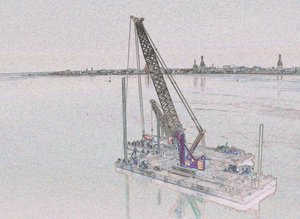 There comes a time when simply capturing the action of constructing the
new Cooper River Bridge approaches blindly following a recipe - and
I try to avoid falling into a rut. I have standard
places that I go, standard sets of photos that I take and standard ways
to process the images for placement in these web pages - all the ingredients
of a rut. Several weeks ago
I began experimenting with ways to alter the images so that they
took on the characteristics of a sketch. I cannot draw an attractive
stick figure, so for me, this was an opportunity to explore something that
I was totally incapable of doing on my own.
There comes a time when simply capturing the action of constructing the
new Cooper River Bridge approaches blindly following a recipe - and
I try to avoid falling into a rut. I have standard
places that I go, standard sets of photos that I take and standard ways
to process the images for placement in these web pages - all the ingredients
of a rut. Several weeks ago
I began experimenting with ways to alter the images so that they
took on the characteristics of a sketch. I cannot draw an attractive
stick figure, so for me, this was an opportunity to explore something that
I was totally incapable of doing on my own.
When I look at a sketch, I see the outlines of objects the artist projects.
So I started with processing an image with an edge detection algorithm. These
algorithms compute the difference in intensity of adjacent picture elements
(pixels). When the intensity difference is small, then the point appears
black. When the intensity is large, then the point appears white.
Consequently edges (where there is a large intensity difference) will appear
as while lines. But an artist sketches with a black pencil, so I inverted
the image - white became black and black became white. Because these
are color images, edges are computed for each of the three colors - red,
green and blue. I then alter the black-white range of intensities
so that I get a more balanced image. The results, as seen here, are
interesting. Bibi, an art history student at UC Berkeley and friend of our
family finds that these transformations bring something new to the art
table - an improvement beyond simply copying an artistic style.
posted at: 05:45 | path: | permanent link to this entry
Sun, 01 May 2005
May 1, 2005: Adventures with elevators and the traveler
 Yesterday I met Murray Feldman and indirectly Bill Nesteruk and his
company, Specialized Engineered Products Ltd. Bill creates these
modern marvels that transport stuff horizontally (as with the bridge
traveler) as well as vertically (or almost vertically) - i.e. the
bridge elevators. Murray makes them work in the field.
Again, design and engineering of the traveler
and elevators generated for me, a quiet smile.
Yesterday I met Murray Feldman and indirectly Bill Nesteruk and his
company, Specialized Engineered Products Ltd. Bill creates these
modern marvels that transport stuff horizontally (as with the bridge
traveler) as well as vertically (or almost vertically) - i.e. the
bridge elevators. Murray makes them work in the field.
Again, design and engineering of the traveler
and elevators generated for me, a quiet smile.
The traveler, used for cleaning and inspecting the underside of the bridge,
is a necessity. Similarly, the four elevators that travel up and down
the inclined surfaces of the east and west pylons, provide access to the
pylon base, the crossbeam and the top. I experienced these elevators
when I was learning from Freyssinet about building stay cables - but
somehow the issue of traveling up and down an incline where the angle
of the incline changes at the pylon crossbeam never caught my curiosity.
posted at: 10:00 | path: | permanent link to this entry
Thu, 28 Apr 2005
April 28, 2005: Getting a presentation together
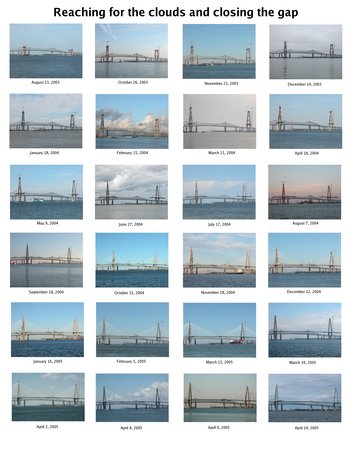 Looking at the photos from the past 21 months reminds me of how much
change has occurred - in both the bridge construction as well as weather
and light conditions. Typically I
experienced early morning conditions from October to April and then
switched to afternoon photos from November until May. This was primarily
in response to the sun's position (in the morning) relative to the line
connecting my photo
spot with the new Cooper River Bridge. I experienced clear weather, cloudy
weather, fog, rain and nearly hurricane conditions. By and large most of
the details of the photo conditions are long lost memories - a result of
the biologial
forgetting process.
Looking at the photos from the past 21 months reminds me of how much
change has occurred - in both the bridge construction as well as weather
and light conditions. Typically I
experienced early morning conditions from October to April and then
switched to afternoon photos from November until May. This was primarily
in response to the sun's position (in the morning) relative to the line
connecting my photo
spot with the new Cooper River Bridge. I experienced clear weather, cloudy
weather, fog, rain and nearly hurricane conditions. By and large most of
the details of the photo conditions are long lost memories - a result of
the biologial
forgetting process.
Looking at these photos reminds me of the rich variety of viewing conditions
I experienced as well as the development of the bridge.
Organizing them as a time
lapse photo stream seems like an interesting way to view almost 2 years of
fun. I have started with 3 compositions: growing the west span,
growing the east span and reaching for the clouds while closing the gap.
posted at: 08:25 | path: | permanent link to this entry
Sun, 24 Apr 2005
April 24, 2005: Closing the loop
Way back in January, when there was a gap separating the east and west
main spans, I
took a photo of the crane used to lift edge and floor girders from barges
to the deck and then hold them in place while the iron workers attached
the splice plates.
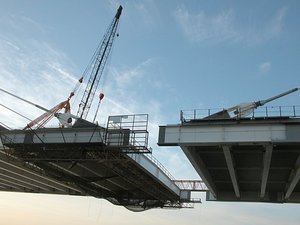 Here is the "Last Dinosaur Standing" as seen from the old Pearman bridge.
(Click to see
the story about Philip and the Last Dinosaur Standing.)
Yesterday I was taking some photos of the main span paving and two guys
walked up and started talking - they were Philip and Lewis. Philip, I sort
of knew because of email from his mom and wife. I had never met Lewis but
had watched Lewis (and Jack) attach the splice plates that linked the north
side of the east and west edge girders - thus bridging the gap.
Here is the "Last Dinosaur Standing" as seen from the old Pearman bridge.
(Click to see
the story about Philip and the Last Dinosaur Standing.)
Yesterday I was taking some photos of the main span paving and two guys
walked up and started talking - they were Philip and Lewis. Philip, I sort
of knew because of email from his mom and wife. I had never met Lewis but
had watched Lewis (and Jack) attach the splice plates that linked the north
side of the east and west edge girders - thus bridging the gap.
But yesterday was special. I was able to meet both of them, talk a bit and
for me, close the loop from distant observer to acquaintance. This
closes another gap, the people gap, and enables my understanding of the
bridge project at
both the technical level as well as at the people level.
The bridge project has impressed me from the people perspective. I have come
to know many people associated, either locally or remotely, with the building
of the new Cooper River Bridge. First Bill Mankin
from High Steel Structures, then David Wertz (SCDOT) then Wade Watson (PBC)
then Peo Halvarsson (Skanska and PBC), Marvin Tallent (Flatiron and PBC)
and Oliver Forget and his Freyssinet team, Wilbur Poole (PBC)
and on and on the list goes. Everyone has helped me understand some aspect
of our bridge project and has given generously of their time.
Helping me understand different components of bridge building has enabled
me to convey what was happening on the main span and approaches with
both the local Charleston community as well as our Internet community. What
pleases me, from my MUSC perspective,
is the opportunity to share the work product of my
hyperactive curiosity with other members of the MUSC community as well as
young learners outside MUSC (particularly with Jonnell at E. L.
Frierson school (Wadmalaw)) - and illustrate the opportunities Google
provides for building episodes of "just-in-time" learning. All these lessons
help me better understand the
IT infrastructure needs at MUSC that facilitate
the paradigm shift from "just-in-case" learning (that is compromised by
the the biology of the forgetting process)
and "just-in-time" learning (which is much more immune to the forgetting
process). The real winner is MUSC which now, thanks
to my bridge friends, has a rather
unconventional source of new insights into learning in general and
Internet-centric learning in particular.
posted at: 15:31 | path: | permanent link to this entry
Fri, 22 Apr 2005
April 22, 2005: Springtime in Charleston
Yesterday while walking home from MUSC, the sun touched some spring flowers in
a remarkable way. Similarly, last night we had an
almost full moon. So here is springtime in Charleston.
(And I do not yet have a firm date for when the new Cooper River Bridge will
formally open. I shall post it here in our blog when I have a pretty firm date.)

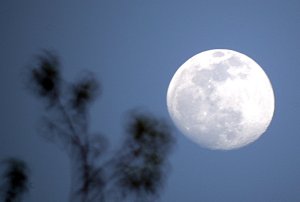
posted at: 10:00 | path: | permanent link to this entry
Thu, 21 Apr 2005
April 21, 2005: Another kind of cable strand
As you know, I am chasing the question: What is the meaning of life,
the universe and everything - as stated in the Hitchhikers Guide to the
Galaxy. Said another way, is there life after our adventure with the
new Cooper River Bridge?
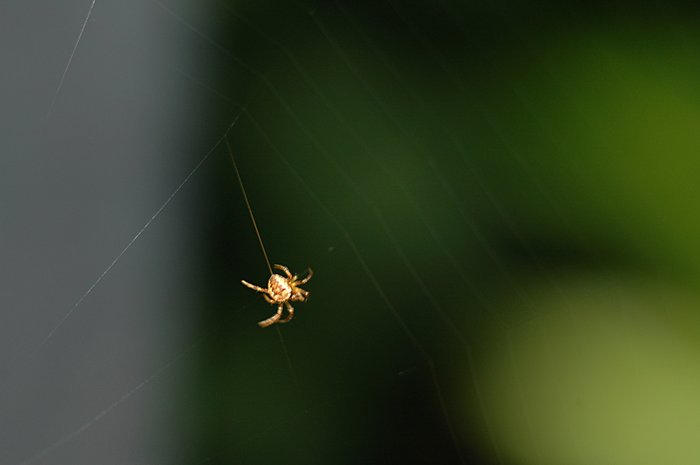
Yesterday was simply chaos cubed. My primary web server (monitor) died while
I was deleting some old files in order to free up some space. Obviously I
deleted something that should not have been deleted - so from about 1pm until
4pm - my site was dead and I was frantic. Clearly, I needed a distraction.
Last night, Ellen and I had a
quiet dinner and talked a bit about our projects. Now is when baby spiders
start to appear in Charleston, so I went out about 7:30 pm looking for our
evening spiders (
Neoscona hentzi or barn spider).
These little
wonders build their webs in the early evening and destroy them in the early
morning - at least usually. I found a few babies (about 0.5 cm in diameter)
in our garden and tried to take some photos, but the conditions
were not good, a gentle breeze was blowing the spider and web in and out of the
focal plane and I had no tripod.
Knowing that they would still be there in the
morning, I returned about 5:30am, with camera, tripod and chair. To my surprise
one was rebuilding her web instead of unbuilding it. I set up the camera,
found a good focus and with a flashlight to illuminate her, started taking
photos. I got lucky and one photo showed her with a silk strand extending
from her spinneret. Just like
Freyssinet unwinding strands
from a big spool of cable,
these little wonders synthesize and extrude silk from a
spinneret and build strands in an as
yet unknown manner. So above is a photo of her, extruding a silk strand
and her weaving. I am accumulating these images and a story which
are available here. Earlier photos
of a (large) adult
Neoscona hentzi are here. And
all of my spider (and underwater) photos can be found
here.
Meanwhile,
I have sent email to the Boston company that was awarded the contract to
remove the old bridges - but so far, no reply but I am cautiously optimistic.
No matter what, I plan to take a routine data set each week starting whenever.
posted at: 17:21 | path: | permanent link to this entry
Tue, 19 Apr 2005
April 19, 2005: What to do next?
Now that the two main spans have been joined and the two tower cranes have
been disassembled very little change is visible from the S.C. Aquarium
and from my bicycle as I ride
across the old bridge. So continuing my weekly set of standard photos
will bring us little new
data. The work on the East Bay on ramp continues and I shall continue
to track this. But I am rapidly running out of ideas. So, if you have
a burning question, now is the time to add your input into our bridge
project. Send me email with your ideas.
And another request. I am thinking about building a photo exhibit selected from
the 6000+ photos I have taken over the past 18 months. The idea is to
provide something interesting from an art perspective as well as an
opportunity to see some of the temporal changes in major bridge features. The
question again is what is interesting for all of you? I have thought about
the following topics:
- Monthly view of the two pylons and closing the gap. I have photos from
August 2003 until now capturing most of this.
- Building the east approach (as seen from my bicycle rides)
- Building the east deck
- Building the west deck
- Building the west approach
- Building a stay cable (Freyssinet)
- Images that just happened - mostly photos that show aspects of the bridge
in different light.
Lee, at
Duncan and Parnell
here in Charleston, can make large (4 ft. x
whatever length) inkjet prints of image compositions. Lee has helped me with
some test prints showing the time sequence of closing the gap on a textured
paper that really brings the images to life. Exploring the presentation
in this manner has challenged me - how to make this something other than a
group of plain jane photos. Using textured paper amd organizing multiple
images on the same paper brings something new to this presentation.
I have also had
Shutterfly print some test
images in a large format: 11x14 and 16x20. Both sizes are amazing and there
is no observable evidence that indicates the digital nature (5 megapixel)
of the images. For me, this was a big surprise.
So again - any ideas about the topics and image composition of such an
exhibition that would make it interesting for you?
What would grab your attention and attract you for a closer look? Again
send me email with your ideas. I shall make an additional tab on the top
menu bar of our bridge web pages so that you can see what I am thinking and
display your suggestions.
Thanks.
posted at: 05:58 | path:
|
permanent link to this entry
Wed, 13 Apr 2005
April 13, 2005: A bit of history
 John Baxley, an aerial photographer from Springfield, SC, has found
a bit of Cooper River Bridge history.
Almost every visit I make to the new bridge
coincides with a cargo ship or tanker sliding along the Cooper River and
under the bridge. During the transition from a web site for my grandchildren
to what it is today, I remember reading some discussion
about the islands that were built at the base of the east and west pylons.
Specifically, these islands were designed to be sufficiently large in diameter
to prevent a ship from colliding with the pylon.
John Baxley, an aerial photographer from Springfield, SC, has found
a bit of Cooper River Bridge history.
Almost every visit I make to the new bridge
coincides with a cargo ship or tanker sliding along the Cooper River and
under the bridge. During the transition from a web site for my grandchildren
to what it is today, I remember reading some discussion
about the islands that were built at the base of the east and west pylons.
Specifically, these islands were designed to be sufficiently large in diameter
to prevent a ship from colliding with the pylon.
As a relatively newcomer to Charleston (we moved from Chapel Hill in 1998),
I am not aware of much of the history and stories surrounding the older
members of the Cooper River Bridge family. Many of you have told me
stories of family experiences with the bridge that bring a personal touch
to my understanding. However, thinking about the earlier lives of the
Cooper River Bridges never clicked
until John sent me this photo of a collision
in 1946. Clearly, historical information is as important to our web project
as today's images. Another nice contribution to our project. Thanks, John.
And a P.S. Tim Linder frequently contributes to our project and dramatically
improved the quality of the original image. Thanks to you also, Tim.
Another P.S. - Jim Bogle from Columbia remembers the story of the
collision of the Nicaragua Victory and the Grace Bridge as told by
his parents. According to him, the Army rigged a Bailey Bridge until repairs
could be done. The opportunities for walking across the Grace Bridge
as I build the story of the
Unbuilding of the Grace and Pearman Bridges are rapidly disappearing. With
input from Jim and John - I shall be much more attentive to the Grace
structure and see if there are any residual signs of the collision.
posted at: 11:24 | path: | permanent link to this entry
Fri, 01 Apr 2005
April 1, 2005: A new project
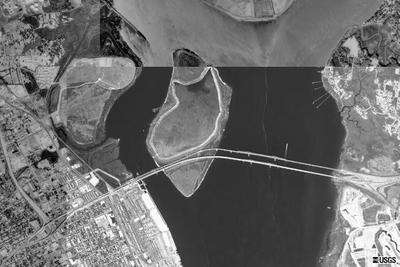 Tim Linder has a great idea. What about collecting aerial and satellite
images acquired during the construction of the new Cooper River Bridge.
We found this image from the US Geological Survey (1999).
In addition, the
US Geological Survey has a very useful image browser. This link includes
southern South Carolina.
Terraserver.com has a more
recent (October 13, 2003) photo from GlobeXplorer at coordinates:
Latitude: 32.8070077 , Longitude: -79.927839 .
Tim Linder has a great idea. What about collecting aerial and satellite
images acquired during the construction of the new Cooper River Bridge.
We found this image from the US Geological Survey (1999).
In addition, the
US Geological Survey has a very useful image browser. This link includes
southern South Carolina.
Terraserver.com has a more
recent (October 13, 2003) photo from GlobeXplorer at coordinates:
Latitude: 32.8070077 , Longitude: -79.927839 .
Terraserver (support@terraserver.com) readily gave me permission to use their 2 meter
(Oct 13, 2003)
resolution image of the construction site. In addition, I found imagery at
NASA's Gateway to Astronaut Photogrphay of
Earth.
I have sent email to
Spot Image in France, another source of satellite imagery.
My experience is that "front" doors
sometimes don't work as well as some "back" doors. So if any of you have some back door
contacts with satellite imagery groups -
send me
email with your information. I shall build a new page
of
satellite imagery with what we are able to locate. Thanks
posted at: 23:55 | path: | permanent link to this entry
Mon, 28 Mar 2005
March 28, 2005: This past weekend was full of surprises.
First the
Charleston Post and Courier (specifically Jim Parker and his team)
ran a wonderful piece about me, the bridge / spider web pages
and issues of
learning, forgetting and the Internet that are near and dear to my heart.
In addition, I received more than my usual weekend share of email about
the bridge web pages. As many of you know, I love learning and enabling
others to learn. Among the weekend emails, Lewis Hudgins of Athens Georgia
related a delightful story about the early days of the project.
"I lived in Charleston for several years. I was Joe Riley's Executive Assistant.
I didn't think the nuances of the construction could possibly interest me as
much as the prolonged political intrigue which, happily, resulted in an
agreement to get the new Cooper River Bridge built. I was wrong. Your pictures
and narratives have been wonderful. It made all of us feel we were up there
with the crews. Also, it makes us want to know more about them and what
happens to them now. And, the awesome, technical aspect of the work was made
easier to understand because of you. (Who knew about the wax?)"
What we have all created with this web site, I believe, is a new sense of
community and being part of something that is remote from many of us.
As many of you know, many engineers and lay people have provided me with
particular insights and questions. PBC, SCDOT, Freyssinet, High Steel
Structures and the FHWA Bridge Division, have opened many
doors that gave me an insider look at things I never imagined (like injecting
wax into the cable anchors). Together we have built a learning site where
we are all able to contribute in many different ways. This is my time to
thank all of you!!!
posted at: 13:57 | path: | permanent link to this entry
Sun, 20 Mar 2005
March 20, 2005 Another attempt in improving the usability of these web pages
Each week I receive email from a number of you requesting some new insights
(for example, tracking the progress of the approaches or tracking the
unbuilding of the west tower crane). As I put these stories together and
increase the weekly set of routine photos, I wonder how anyone but me can
find anything among these pages.
Over the past year and a half, the organization
has progressed from 1 long linear web page to a group of pages to groupings
of pages. I have created an archive page with links to everything. But
again, unless you know what is in the archived pages, it might take several
attempts to locate what you are looking for. Last week, Jason Osborne
of Clemson, made a wonderful suggestion - why not put a last updated time
stamp on the menu bar and in the archive. I am feeling a bit guilty that
I did not think of this a long time ago. So now we have time stamps
indicating the last time I updated a story.
But today I thought about Google. Why not include a Google search box in
the header of each story and limit the Google search to my web site. Google
has a simple way to constrain search results by including the
clause site:ravenelbridge.net in the search expression. So I set up
a Google search box with this embedded in the search expression. Let me know
if this helps locating things.
posted at: 10:00 | path: | permanent link to this entry
Fri, 11 Mar 2005
March 11, 2005 Closing the Gap and Our Website Community
 As many of you know, these bridge photo essays started as a simple way
for my grandchildren to watch the growing of the new Cooper River Bridge.
Sometime in the early spring of 2004, Bill Mankin of High Steel Structures,
sent me email with some comments about the web site. High Steel
fabricated all the edge and floor girders for the main span.
Bill's email and our subsequent exchanges changed
the web site from a Read Only web page to an interactive
Read Write web site that reflected information from our web
page community. Bill helped me understand some of the issues associated with
erecting the steel girders and later invited me to visit their facility
in Lancaster Pa.
As many of you know, these bridge photo essays started as a simple way
for my grandchildren to watch the growing of the new Cooper River Bridge.
Sometime in the early spring of 2004, Bill Mankin of High Steel Structures,
sent me email with some comments about the web site. High Steel
fabricated all the edge and floor girders for the main span.
Bill's email and our subsequent exchanges changed
the web site from a Read Only web page to an interactive
Read Write web site that reflected information from our web
page community. Bill helped me understand some of the issues associated with
erecting the steel girders and later invited me to visit their facility
in Lancaster Pa.
Many engineers and many more armchair engineers have joined our
conversation. When I encountered puzzles, many were quick to respond
with answers. For example Joe Krolak, an hydraulic engineer with
the Federal Highway Administration, Bridge Divistion, helped me
understand how one stabilizes barges that support cranes while
erecting girders while Boyd Gregg,
a civil engineer with Black & Veatch in
Alpharetta, Ga helped me understand the concept of tensioning - specifically
when I encountered PBC tensioning the lateral tendons that stabilized the
central segment of the east and west pylons. So I copied and pasted
Boyd's explanation into the details
web page. When I really got into engineering trouble, David Wertz with
SCDOT and Marvin Tallent with PBC helped me understand what was happening.
More recently, Peo Halvarsson provided opportunities to explore different
aspects of building the main deck and Oliver Forget with Freyssinet
helped me understand erecting cable stay pipes and pulling strands of
cable. I had a chance to see many things that simply increased my
curiosity. During these times, I met Wilbur Poole, an iron worker who
also manages the hydraulic systems used to position the deck. All these
folks were my teachers and I transferred what I learned to these
pages.
But many many people simply sent email to encourage me to continue. These
are the people that energized me to continue my weekly visits to the
SC Aquarium to take my "core data". Then Tina Cotter got into the picture.
Her husband, Philip, an iron worker, named one of the deck erection
cranes "Last Dinosaur Standing", the kind of humor that really turns me
on. When Tina told me the crane story, I could not resist adding some humor
to the placement of the last concrete floor panel - was Philip signaling
the crane operator, or was Philip secretly waving to Tina? Look at the
photo above and you be the judge.
What I am trying to say is that this web site is a community project - not
just Frank Starmer taking photos for his grandkids. The stories and
photos reflect significant influences from two of my kids -
Michael told me a long time
ago that my photos were chaos. "Never take a photo unless you are prepared
to tell a story". Not only good advice, but great advice. Josh then
introduced me to the humor side of photo essays with his dialog associated
with photos of my work in south India
(2001).
Gene Stead, chairman of Medicine at Duke,
was my first boss and taught me
the joy of learning. Gene asked lots of questions - not because he was
testing people, but because he was curious. Gene helped me to understand
that being curious was OK - not something that should be suppressed as
one becomes a teenager. My dad was also very curious and shared with me
that he never met someone from whom he could not learn something.
The Internet and Google level the playing field for all of us
curiosity chasers. And these web pages are really an experiment in what
I call Internet-centric learning. The days of teachers and
students are nearing an end and a new Internet-centric learning
paradigm is evolving. As with Gene - we are all learners in this world -
traditional teachers are more like senior learners while traditional
students are simply junior learners.
So these web pages are all about learning, my curiosity and
your encouragement. What started as a simple set of photos has evolved to
what we have now - a sort-of read write web site where many of you
contribute to my understanding aspects of building the new Cooper River Bridge.
I am grateful for your help, for your curiosity and for your encouragement.
posted at: 10:11 | path: | permanent link to this entry
Thu, 10 Mar 2005
March 10, 2005 Unseen tal
I suppose that some of you will think I've completely flipped out. Thinking
about where to go with the web pages and the images that I have acquired over
the past 20 months has led me down many paths. One suggestion by a friend
is to take a group of photos and make an art show. Knowing very little about
formal art (except what I learn from Josh and Bibi), Ellen played the idea of
our friend Debra Bieber, now in Dhaka Bangladesh. We met Debra and her
husband, Glen, while I was a visiting professor of Biomedical Engineering at
the Indian Institute of Technology, Madras (now Chennai). We were there from
1993 - 1994 and had the cultural experience of our life. During this time,
I was successful in managing my lab at Duke via the Internet, one of my
early experiences with Internet-centric life.
Anyway, I was considering three segments of an exhibit: time sequence of
the bridge growth, people and processes. As many of you know, I enjoy
learning from anyone and the bridge has provided many opportunities to learn
something of bridge technology. So Debra suggests the title "Unseen tal". I
am thinking, Deb has surely flipped out. Then Debra goes on to remind me
that tal is the rhythmic basis of classical (Carnatic (south) and
Hindustani (north) ) Indian music. I remembered going to my first classical
music performance at IIT (in the OAT). It was my first encounter with
classical Indian music and not at all what I expected. After the first few
numbers, I was ready to leave since it was completely not understandable.
There was a singer, drummer (tabla), violinist and veena and just as I was
about to give up, I suddenly realized that there was a rhythm (from the tabla
and veena) and a violin echo of what the singer was singing. And the singing
was not what I thought of as western singing but rather the singer was playing
his voice. All was suddenly understandable and enjoyable when I escaped from
my western paradigm of singing words and harmony and
saw that the singer was playing his instrument just as the violinist was
echoing the improvised composition with his instrument.
Tal (see the references below) is all about rhythm and Debra saw in my
photos a rhythm that is unseen by those viewing the bridge from afar. So
she composed the word, Unseen tal. I thought this was brilliant and felt
that Deb had caught the driving force of my bridge curiosity and my
passion for capturing the rhythm of the building of the bridge. So I am
thinking and playing with some ideas for a presentation.
posted at: 08:01 | path:
|
permanent link to this entry
Wed, 09 Mar 2005
March 9, 2005: Making ends meet (my wife wishes she could use hydraulic jacks and fork lifts to deal with family budget issues).
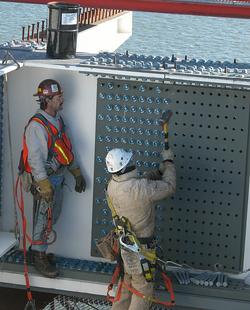 Closing the last gap (maybe last gasp?). Yesterday PBC and their iron
workers closed the final gap linking the west and east decks. Peo and his team
coaxed the two platforms into perfect alignment so that the splice plate could
be pinned and bolted. Shown here is driving the first drift pin into the
vertical splice plate linking the center edge girder with the south 216
edge girder.
Closing the last gap (maybe last gasp?). Yesterday PBC and their iron
workers closed the final gap linking the west and east decks. Peo and his team
coaxed the two platforms into perfect alignment so that the splice plate could
be pinned and bolted. Shown here is driving the first drift pin into the
vertical splice plate linking the center edge girder with the south 216
edge girder.
It was windy - really very windy. I discovered that the virtue of an
8 lane wide roadway is that when the wind blows your glasses - it takes a long
time to cover the width of the road and disappear. Fortunately I quickly
retrieved them. But in spite of the wind, the work continued.
I soon discovered some of the tricks these guys use to encourage the two decks
to behave and align themselves. Two major tools:
- Altering the horizontal alignment with hydraulic jacks (located at the
pylon).
- Altering the vertical alignment with counterweights. In this case,
the counterweights were mobile - consisting of fork lifts that moved toward
or away from the gap, with or without counterweights.
I would not have
thought changing the alignment a few inches would be so involved - and yet
relatively straight forward. It was a joy to watch this team do their magic!.
Today they are completing bolting up the vertical splice plates and horizontal
splice plates.
posted at: 10:00 | path:
|
permanent link to this entry
Sat, 05 Mar 2005
March 5, 2005: A visit from my dad
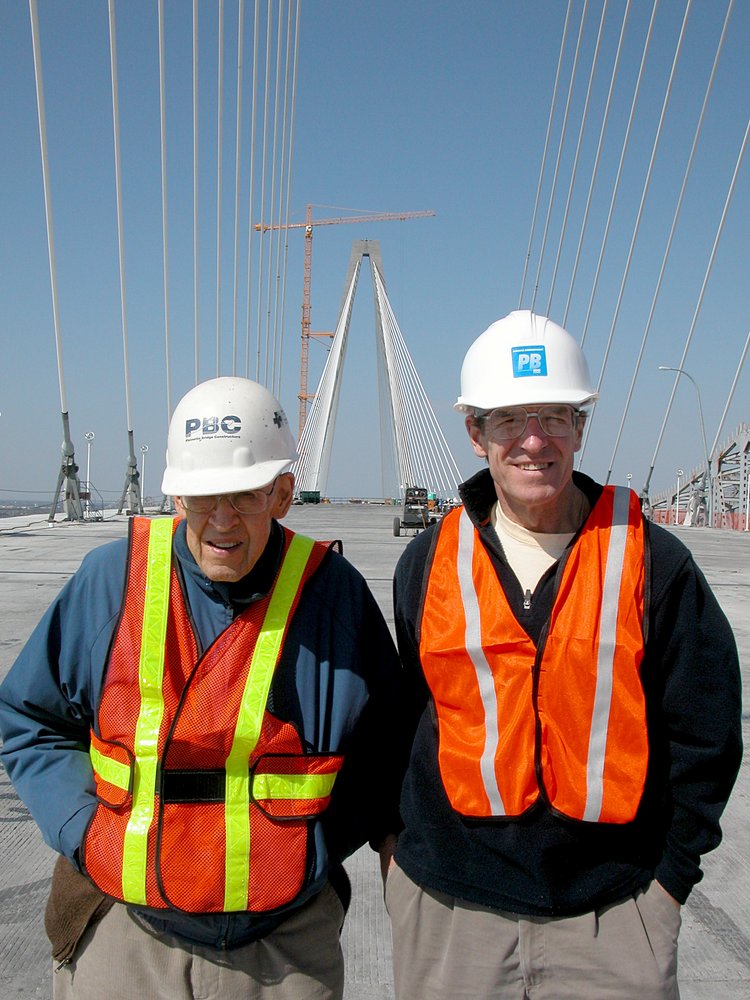 My dad transferred many gifts to me. But perhaps the greatest gift was that of
endless curiosity. When I was a kid - we used to travel to different
construction sites where he was installing elevators. Sometimes on the
weekends, we would visit a sick elevator and repair it. Sometimes we
simply walked from our home in Greensboro to the railroad switch house. We
would sit for hours watching the trains pass. We would count the cars.
Sometimes, we would enter the switch house and if we were good and very very
lucky we got to throw swiches which changed the communication between
parallel tracks. All the time, he displayed not only curiosity but an
enquiring mind.
My dad transferred many gifts to me. But perhaps the greatest gift was that of
endless curiosity. When I was a kid - we used to travel to different
construction sites where he was installing elevators. Sometimes on the
weekends, we would visit a sick elevator and repair it. Sometimes we
simply walked from our home in Greensboro to the railroad switch house. We
would sit for hours watching the trains pass. We would count the cars.
Sometimes, we would enter the switch house and if we were good and very very
lucky we got to throw swiches which changed the communication between
parallel tracks. All the time, he displayed not only curiosity but an
enquiring mind.
Yesterday my brother, Jack, phoned from Burlington, N.C. He had just driven to
my dad's place from Pennsylvania and announced, "can we visit"? Of course,
and so about 7pm last night they appeared. My dad is 88 and still just
as curious as ever. I knew of his love of construction and thought of the
possibility to drive to various places and view the new Cooper River Bridge.
The perfect opportunity for an unplan-plan.
Every time I said "Cooper River Bridge" he told a story about elevators
he installed at Santee Cooper - probably 50 years ago (I don't really know).
Anyway, this morning, we started our tour. We saw the bridge from many
perspectives. All the time he was telling
stories and looking and asking questions: a 16 year old curiosity hard
at work.
posted at: 12:15 | path: | permanent link to this entry
Tue, 01 Mar 2005
March 1, 2005: A Dinosaur story
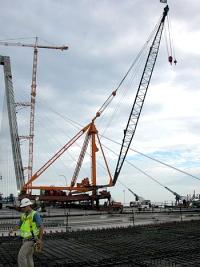 During the growth of the deck, there were 4 cranes, one located at each
end of each deck. Philip Cotter named one of them
"Last Dinosaur Standing" and I have a few
photos of this animal. I was told that each crane was an antique - over
100 years old. I've not been able to confirm this, but perhaps it is correct.
If so, then these cranes have seen many projects and I can imagine the
stories they have to tell. I have assembled a few photos
of
the Last Dinosaur Standing and placed them near the end of the close-up
page. Perhaps someone knows more about these creatures? If yes - don't keep
it a secret.
During the growth of the deck, there were 4 cranes, one located at each
end of each deck. Philip Cotter named one of them
"Last Dinosaur Standing" and I have a few
photos of this animal. I was told that each crane was an antique - over
100 years old. I've not been able to confirm this, but perhaps it is correct.
If so, then these cranes have seen many projects and I can imagine the
stories they have to tell. I have assembled a few photos
of
the Last Dinosaur Standing and placed them near the end of the close-up
page. Perhaps someone knows more about these creatures? If yes - don't keep
it a secret.
Many of you have discovered this page - an exploration of using a blog
(webLog) to express some of the content of these pages. I discovered
blogs from my IT Lab brain trust - a group of the greatest and friendliest
guys at MUSC. I was reluctant to engage this new tool - but as the bridge
web site spun out of control, some sort of organization was necessary. This
blog is a test of whether I can maintain some sort of links with photos that
are posted to different sections of the site and maintain a 1-way dialog with
all of you.
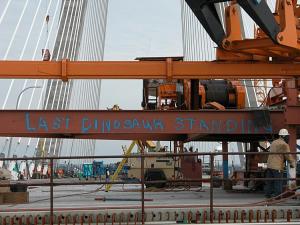 If you have not encountered blogs - it is the tool that is transforming web
resources from read-only to read-write. Blog tools permit individuals to
post thoughts and observations to the web without the geek-skills necessary
to manage a web site. This morning I ran across an article that
addesses
Blogs in education.
The thoughts parallel my thoughts about
Internet-centric learning
(see also
Restoring the joy of learning ) and the evolution of the bridge web
site - as a learning tool. I suggest you check it out and share your
impressions with me and your friends.
If you have not encountered blogs - it is the tool that is transforming web
resources from read-only to read-write. Blog tools permit individuals to
post thoughts and observations to the web without the geek-skills necessary
to manage a web site. This morning I ran across an article that
addesses
Blogs in education.
The thoughts parallel my thoughts about
Internet-centric learning
(see also
Restoring the joy of learning ) and the evolution of the bridge web
site - as a learning tool. I suggest you check it out and share your
impressions with me and your friends.
posted at: 09:55 | path: | permanent link to this entry
Mon, 28 Feb 2005
February 28, 2005: Overview of the bridge and approaches

posted at: 04:55 | path: | permanent link to this entry
Fri, 25 Feb 2005
February 25, 2005: Time for another reorganization
It has come time to separate my one way dialog (more like a web log or blog)
into a separate section. Matthew, Brian, Satya and Christopher, my IT Lab
brain trust, are pushing for a major reorganization along the lines of a
Blog. They assert, probably correctly, that all my text sometimes gets in
the way of my story. I have started experimenting with rebuilding the bridge
story with Blosxom, a blog (and a preliminary view will be available soon).
I am also exporing placing all the images in a database, with a separate tag
field so that you could pull back all images with the same tags. I am
thinking that providing a search facility will help some of you since I have
little insight into the ways many of you wish to explore this story.
posted at: 18:23 | path: | permanent link to this entry
Thu, 17 Feb 2005
February 17, 2005: A request for help.
Now that the bridge is nearing completion, I am
thinking about what to do with these web pages - and perhaps how to better
package elements of this story. There are three ways to go about this:
- I can assume I have all the knowledge and do it myself
- I can appoint a committee and develop guidelines - following a sort of
proprietary development strategy
- I can use the communicative power of the Internet and manage our affairs
with an open forum where we all are enabled to contribute to this concept
My explorations with Internet-centric learning and using the communicative
power of the Internet to engage anyone has demonstrated to me the utility
of open development - whether software or these bridge pages.
My brain trust (the MUSC IT Lab)
is pushing me to rebuild the pages using a
Blog or something similar
to a wikipedia
to facilitate organization
and navigation between story segments. Jim Abrahamson, friend of mine in
Chapel Hill, suggested that I build
a photo essay around the people that I have encountered during this
adventure - and title it: The Living Bridge. After all, this
comissioned composition for steel,
concrete, bolts, surface treatment, cables, etc did not just happen, but
required real people to do the work. PBC,
SCDOT, High Steel Structures and Freyssinet have provided me with unique
opportunities to watch (and photograph) their folks as they created the
new Cooper River Bridge. I would like to know your thoughts. What would
be interesting to you?
What would be a useful way to package what we have jointly built over
the past 18 months. How can I (we) use this opportunity to ignite
the curiosity of younger learners? Send me your thoughts and ideas by
email and tell me
what would bring you and your friends and family back to this site?
Can these web pages continue to evolve beyond the date of bridge completion,
developing new life that continues to bring weekly or monthly something new?
As you know, this has been an experiment with
what I call Internet-centric learning and I have
already learned more from you than I would have imagined (and the
"you" is an international "you"). I am hooked on finding a way
to continue the experiment and then transfering what I learn to the MUSC
learning environment.
posted at: 17:21 | path: | permanent link to this entry
Sun, 13 Feb 2005
Feb 13, 2005: Feeling the construction process.
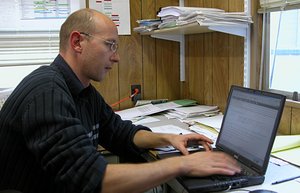 For the past few weeks, I have been following
Oliver Forget and his Freyssinet team - more like a musical ensemble and
a conductor. As I watched, I came to know several of his guys and my story
began to change from a technical photo essay to a more personal photo essay.
Just as I have been learning from Bill Mankin (High Steel Structures),
David Wertz (SCDOT) and Marvin Tallent (QA/QC PBC), there is more to sculpting
a bridge and doing it with excellence and beauty than simply assembling pieces
of a tinker toy set. As the bridge construction winds down, I want to bring
more of the
people side of the story to these photo essays.
For the past few weeks, I have been following
Oliver Forget and his Freyssinet team - more like a musical ensemble and
a conductor. As I watched, I came to know several of his guys and my story
began to change from a technical photo essay to a more personal photo essay.
Just as I have been learning from Bill Mankin (High Steel Structures),
David Wertz (SCDOT) and Marvin Tallent (QA/QC PBC), there is more to sculpting
a bridge and doing it with excellence and beauty than simply assembling pieces
of a tinker toy set. As the bridge construction winds down, I want to bring
more of the
people side of the story to these photo essays.
posted at: 10:00 | path: | permanent link to this entry
Sun, 23 Jan 2005
Jan 23, 2005: More than photos.
Thinking about the evolution of these pages over
the past 18 months, I realize that what I'm doing is telling a story as it
unfolds -
a story about what I see each week as I look at the bridge construction from
afar (running across the James Island connector at noon).
I have removed "afar" and weekly I take a standard set of
photographs from the SC Aquarium and while riding a bicycle over the old bridge.This represents the core "data" for my project. From these images, I can
track changes, and when I see something new or puzzling,
I start a side exploration, just as I would in the laboratory. I ask Google somequestions and if what I learn seems useful to share,
it becomes part of the dialog in this photo-essay. For kids, I call this
chasing my curiosity and it is ok not only for kids but also for adults
to chase their curiosity and ask questions. In this manner, there are
no teachers and students but a group of co-learners.
posted at: 06:11 | path: | permanent link to this entry
Sun, 01 Aug 2004
August 1, 2004: A community project
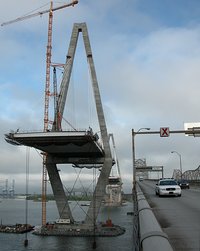 About 7am this morning I was riding my bicycle across the Pearman bridge and
was about half finished with my photo data collection. There was a voice from
somewhere but I paid no attention. Then there was a louder voice and I turned
and it was a Mt Pleasant Police officer who wanted to know what I was doing. I
explained about my weekly photos/web pages and he offered to run interference
for me - which I immediately accepted. It was very reassuring to have an
officer tailing me and making it obvious that there was a slow poke on
the bridge.
About 7am this morning I was riding my bicycle across the Pearman bridge and
was about half finished with my photo data collection. There was a voice from
somewhere but I paid no attention. Then there was a louder voice and I turned
and it was a Mt Pleasant Police officer who wanted to know what I was doing. I
explained about my weekly photos/web pages and he offered to run interference
for me - which I immediately accepted. It was very reassuring to have an
officer tailing me and making it obvious that there was a slow poke on
the bridge.
posted at: 07:00 | path: | permanent link to this entry
Wed, 20 Aug 2003
August, 2003: How this began.
This web page started very innocently. I took my grandchildren to the SC
Aquarium where I took a photo of my grandkids with the new bridge in the
background. About two months later, more grandkids appeared, another
visit to the Aquarium and another photo. When I returned home, I noted
that the bridge had grown enough to notice - so the next week,
I returned to the aquarium to take a photo from the same location. It was
closed (7am Sunday morning) - so I went next door to the pier which became
my permanent data collection spot. The routine of weekly photos changed from
an innocent group of photos for my grandchildren to a web site where my
grandchildren could watch the
progress from their homes in Minneapolis (now Nashville), Allentown
and Louisville. But there is more to this than simply taking photos. Mike,
one of my sons, told me a long time ago that my photos were not
interesting unless I took photos with a mental
image of a story I was trying to tell. Then Josh (another son) showed me
how to make humorous photo essays - starting with our adventures in India.
Since I started the Cooper River Bridge story, many others
have encouraged me to continue - so here are the weekly (mostly) updates
of our cable-stayed new Cooper River Bridge. The lesson? Nothing
happens until you start.
posted at: 08:02 | path: | permanent link to this entry







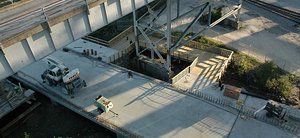 During the construction of the Morrison Street on-ramp, bicycle and pedestrian
walkway, there was an obstacle at the base of the Pearman bridge. A vertical
support structure prevented paving a small section of the bicycle lane. A
small wooden platform was built around the Pearman supports - a sort of
detour.
During the construction of the Morrison Street on-ramp, bicycle and pedestrian
walkway, there was an obstacle at the base of the Pearman bridge. A vertical
support structure prevented paving a small section of the bicycle lane. A
small wooden platform was built around the Pearman supports - a sort of
detour.
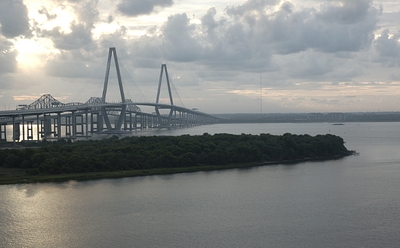
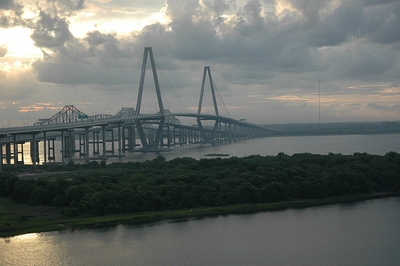

 The fog that day was thicker than pea soup and it was impossible to see
the erection process from the water. So we visited the deck of the
left main span. While waiting for the fog to clear we were invited to
look at the cable installation process inside the west pylon. This was
my first exposure to the French group of Freyssinet. Later, we visited
the top of the west tower and looking down I watched the Freyssinet
guy direct the strands of cables as they were fed from the anchorage
area see (
The fog that day was thicker than pea soup and it was impossible to see
the erection process from the water. So we visited the deck of the
left main span. While waiting for the fog to clear we were invited to
look at the cable installation process inside the west pylon. This was
my first exposure to the French group of Freyssinet. Later, we visited
the top of the west tower and looking down I watched the Freyssinet
guy direct the strands of cables as they were fed from the anchorage
area see ( The crowd was wall to wall people - even 4 hours before the peloton arrived -
and I am impatient and what to do standing in place for 4 hours? I decided
that the crowd and the competition for photos was really worth documenting and
took this photo - just to show all the cameras (count them if you can). I
was about 3 rows back - and the only way I could take an unobstructed photo
was to hold the camera high above my head, aim and click - blindly taking
photos of whatever my camera was pointed toward.
The crowd was wall to wall people - even 4 hours before the peloton arrived -
and I am impatient and what to do standing in place for 4 hours? I decided
that the crowd and the competition for photos was really worth documenting and
took this photo - just to show all the cameras (count them if you can). I
was about 3 rows back - and the only way I could take an unobstructed photo
was to hold the camera high above my head, aim and click - blindly taking
photos of whatever my camera was pointed toward.


 From Walter Baker in California:
From Walter Baker in California:
 Yesterday, Vince Streano, David Wertz and I revisited the top of the
west tower. It was almost 1 year ago (July 21, 2004) that David and
I visited the top of the west tower - at that time looking at a number of
bridge engineering issues. Among them was the cabling process managed
by
Yesterday, Vince Streano, David Wertz and I revisited the top of the
west tower. It was almost 1 year ago (July 21, 2004) that David and
I visited the top of the west tower - at that time looking at a number of
bridge engineering issues. Among them was the cabling process managed
by  Almost a year ago (July 21, 2004),
David Wurtz gave me my first bridge building seminar on the
platform of the
west span. As part of our seminar we made a visit to one of
the cable construction stations in
the interior of the west pylon which is how I discovered Freyssinet.
Later Olivier Forget, the leader of the international
Freyssinet team, as well as
Eduardo, Cyril, Jose, Pavil, Bruno, Philiu and Niko joined our seminar and helped me
to understand the design, construction and testing of stay cables.
Now, a year later, the Tour de France has just started and I am
remembering the excitement of my first visit to the main span. Wade,
Peo, Marvin, Brian, Lori, Wilbur, Derik and many many others gave
these pages a bit of life. Thanks to all of them!
Almost a year ago (July 21, 2004),
David Wurtz gave me my first bridge building seminar on the
platform of the
west span. As part of our seminar we made a visit to one of
the cable construction stations in
the interior of the west pylon which is how I discovered Freyssinet.
Later Olivier Forget, the leader of the international
Freyssinet team, as well as
Eduardo, Cyril, Jose, Pavil, Bruno, Philiu and Niko joined our seminar and helped me
to understand the design, construction and testing of stay cables.
Now, a year later, the Tour de France has just started and I am
remembering the excitement of my first visit to the main span. Wade,
Peo, Marvin, Brian, Lori, Wilbur, Derik and many many others gave
these pages a bit of life. Thanks to all of them!





 Sometimes you never know when your past will catch up with you. When I first
came to MUSC, our outsourced IT support folks could not execute within my
frame of reference - Internet-centric learning. So I formed the Information
Technology Laboratory, aptly named the IT Lab by Nafees BinZafar, one of my
first. The IT Lab was set up to give me the freedom to execute within the
web world and I can honestly say that I have learned more from them than they
from me. I simply ignited their curiosity fuse and then got out of their
way. One of the few rules in the
Sometimes you never know when your past will catch up with you. When I first
came to MUSC, our outsourced IT support folks could not execute within my
frame of reference - Internet-centric learning. So I formed the Information
Technology Laboratory, aptly named the IT Lab by Nafees BinZafar, one of my
first. The IT Lab was set up to give me the freedom to execute within the
web world and I can honestly say that I have learned more from them than they
from me. I simply ignited their curiosity fuse and then got out of their
way. One of the few rules in the
 It is all about people chemistry. New chemical compounds are impossible
as long as the reagents live in their individual bottles. Mix them together,
add a bit of heat (sometimes) and something interesting might happen. The
same with people. When I sit in my office or home, bottled as a chemical
reagent in the supply room, nothing interesting happens. When I get up and
poke around, I collide with others, and the possibility of something
interesting is amplified. So it is with our bridge project.
It is all about people chemistry. New chemical compounds are impossible
as long as the reagents live in their individual bottles. Mix them together,
add a bit of heat (sometimes) and something interesting might happen. The
same with people. When I sit in my office or home, bottled as a chemical
reagent in the supply room, nothing interesting happens. When I get up and
poke around, I collide with others, and the possibility of something
interesting is amplified. So it is with our bridge project.

 Yesterday I met Murray Feldman and indirectly Bill Nesteruk and his
company, Specialized Engineered Products Ltd. Bill creates these
modern marvels that transport stuff horizontally (as with the bridge
traveler) as well as vertically (or almost vertically) - i.e. the
bridge elevators. Murray makes them work in the field.
Again, design and engineering of the traveler
and elevators generated for me, a quiet smile.
Yesterday I met Murray Feldman and indirectly Bill Nesteruk and his
company, Specialized Engineered Products Ltd. Bill creates these
modern marvels that transport stuff horizontally (as with the bridge
traveler) as well as vertically (or almost vertically) - i.e. the
bridge elevators. Murray makes them work in the field.
Again, design and engineering of the traveler
and elevators generated for me, a quiet smile.

 Here is the "Last Dinosaur Standing" as seen from the old Pearman bridge.
(Click to see
Here is the "Last Dinosaur Standing" as seen from the old Pearman bridge.
(Click to see 
 John Baxley, an aerial photographer from Springfield, SC, has found
a bit of Cooper River Bridge history.
Almost every visit I make to the new bridge
coincides with a cargo ship or tanker sliding along the Cooper River and
under the bridge. During the transition from a web site for my grandchildren
to what it is today, I remember reading some discussion
about the islands that were built at the base of the east and west pylons.
Specifically, these islands were designed to be sufficiently large in diameter
to prevent a ship from colliding with the pylon.
John Baxley, an aerial photographer from Springfield, SC, has found
a bit of Cooper River Bridge history.
Almost every visit I make to the new bridge
coincides with a cargo ship or tanker sliding along the Cooper River and
under the bridge. During the transition from a web site for my grandchildren
to what it is today, I remember reading some discussion
about the islands that were built at the base of the east and west pylons.
Specifically, these islands were designed to be sufficiently large in diameter
to prevent a ship from colliding with the pylon.
 Tim Linder has a great idea. What about collecting aerial and satellite
images acquired during the construction of the new Cooper River Bridge.
We found this image from the US Geological Survey (1999).
In addition, the
Tim Linder has a great idea. What about collecting aerial and satellite
images acquired during the construction of the new Cooper River Bridge.
We found this image from the US Geological Survey (1999).
In addition, the







